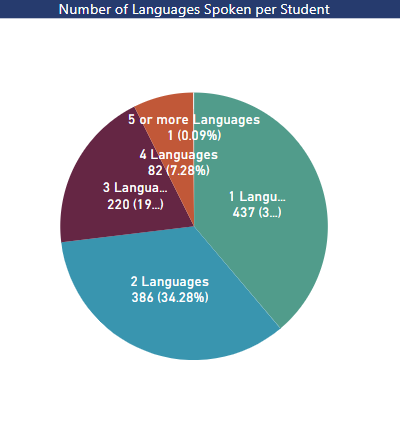The Truth Behind the Tagline

Following the release of data for the current academic year, AUP's multilingualism is investigated.
At the beginning of the semester, incoming freshmen, transfers, and partner students were welcomed by a reiteration of the AUP brochure, boasting 108 nationalities and a promise of multilingualism. From the Arabic whispers of the girls in the second row to the huddled group of laughing French students outside, the tagline seemed fitting. But how much of it is true?
“Tuve clase de ingles esta mañana,” says one roommate on the phone. ("I had English class this morning.")
“Ich habe mein Lieblingsplakat zu Hause vergessen,” says the other, in hushed conversation with her mother. ("I forgot my favorite poster at home!")
It is not inaccurate to say a large portion of AUP is bilingual: 34.28% of students speak two languages. Following close behind are trilinguals, making up almost 20% of the population. According to this semester’s data, one student speaks five languages. But the largest percentage remains monolingual.
Language data from the current academic year. Image credit: Taylor Brooks, Institutional Data Analyst for AUPAs an Anglophone university, English is the only language necessary to operate at AUP. Even in Paris, one can get by without learning French beyond bonjour. This does not necessarily annul AUP’s promise of multilingualism, though.
AUP’s city campus makes one privy to hundreds of languages; the Langues et Grammaires en Ile-de-France project lists Paris as home to Wolof, Swedish, and Tagalog. All three are represented at AUP.
Spoken language cluster for the current academic year. Image credit: Taylor Brooks, Institutional Data Analyst for AUPMultilingualism is as much about culture as it is language. Students who do have intertwined backgrounds share this culture with the rest of the AUP community, especially with those who only speak English. By interacting with a peer who speaks Navajo, for example, students are exposed to traditions they may never have been otherwise.
Intimate interaction with so much culture subconsciously influences how a person interacts with themselves and the social and professional world around them. It also highlights the linguistic difference in something as innocuous as a hand gesture.
When English speakers talk about the past, they might gesture behind them. But in many African cultures, a speaker would gesture forwards because they believe the past is always used to reflect.
Nationalities of students for the current academic year. Image credit: Taylor Brooks, Institutional Data Analyst for AUPAfter the United States and France, UK, German, and Russian nationalities are most common out of the 105 represented. While 80% of students hold only one nationality, almost 2% (19 students) hold three.
Though English-speaking and branded with an American name, AUP fosters a strong sense of multilingualism and multiculturalism within its community. Monolinguals, bilinguals, and perhaps a growing population of pentalinguals bring a unique culture to the AUP student body that confirms its status as “the finest and most demographically diverse American education in Europe.”










